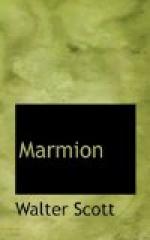line 620. The custom of ringing the passing bell grew out of the belief that a church bell, rung when the soul was passing from the body, terrified the devils that were waiting to attack it at the moment of its escape. ’The tolling of the passing bell was retained at the Reformation; and the people were instructed that its use was to admonish the living, and excite them to pray for the dying. But by the beginning of the l8th century the passing bell in the proper sense of the term had almost ceased to be heard. ’A mourning bell is still rung during funeral services as a mark of respect. See s. v. ‘Bell,’ Chambers’s Encyclopaedia. Cp. Byron’s ‘Parisina,’ St. xv.
’The convent bells
are ringing,
But
mournfully and slow;
In the grey square
turret swinging
With
a deep sound to and fro.’
In criticising ‘Marmion,’ in the Edinburgh Review, Lord Jeffrey says that the sound of the knell rung for Constance ’is described with great force and solemnity;’ while a writer in the Scots Magazine of 1808 considers that ’the whole of this trial and doom presents a high-wrought scene of horror, which, at the close, rises almost to too great a pitch.’
INTRODUCTION TO CANTO THIRD.
’William Erskine, Esq. advocate, sheriff-depute of the Orkneys, became a Judge of the Court of Session by the title of Lord Kinnedder, and died in Edinburgh in August, 1823. He had been from early youth the most intimate of the Poet’s friends, and his chief confidant and adviser as to all literary matters. See a notice of his life and character by the late Mr. Hay Donaldson, to which Sir Walter Scott contributed several paragraphs.’—Lockhart.
There are frequent references to Erskine throughout Lockhart’s Life of Scott. The critics of the time were of his opinion that Scott as a poet was not giving his powers their proper direction. Jeffrey considered Marmion ’a misapplication in some degree of extraordinary talents.’ Fortunately, Scott decided for himself in the matter, and the self-criticism of this Introduction is characterised not only by good humour and poetic beauty but by discrimination and strong common-sense.
line 14. a morning dream. This may simply be a poetic way of saying that his method is unsystematic, but Horace’s account of the vision he saw when he was once tempted to write Greek verses is irresistibly suggested by the expression:—
’Vetuit me tali voce Quirinus
Post mediam noctem visus, cum somnia vera:
“In silvam non ligna feras insanius, ac si
Magnas Graecorum malis implere catervas?’
Sat. I. x. 32.
line 24. all too well. This use of ‘all too’ is a development of the Elizabethan expression ‘all-to’ = altogether, quite, as ’all to topple,’ Pericles, iii. 2. 17; ‘all to ruffled,’ Comus, 380. In this usage the original force of to as a verbal prefix is lost sight of. Chaucer has ‘The pot to breaketh’ in Prologue to Chanon Yeomanes Tale. See note in Clarendon Press Milton, i. 290.




